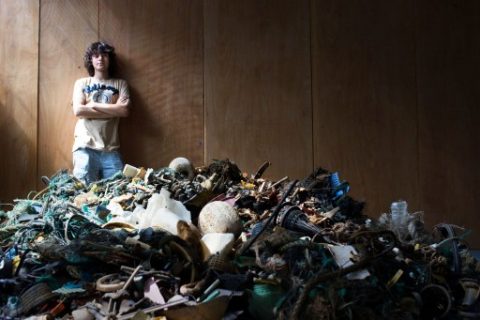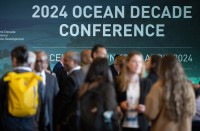
by Jo Biddle
Agence France Presse
UTRECHT, Netherlands (AFP) — A Dutch engineer aiming to clean up vast ocean “garbage patches” of plastic Thursday unveiled a radical design breakthrough, enabling his ambitious project to start two years early.
Boyan Slat’s innovative scheme seeks to use ocean currents to help gather up an estimated five trillion pieces of plastic — everything from bottles, to plastic bags, flip-flops and other detritus — from the planet’s waters.
After several years of research, including the first-ever detailed aerial survey of the largest garbage patch lying in the Pacific between Hawaii and the Californian coast, his Ocean Clean-up scheme has radically overhauled its plans.
Slat, who is still only 22, now hopes to begin deploying the first clean-up system within the next 12 months, instead of in 2020 as first promised.
He also hopes to be able to remove 50 percent of the Pacific patch within five years, compared with initial estimates of 42 percent within a decade.
Defying past gloomy predictions by top experts who said nothing could be done, Slat now believes by 2050 the whole patch could be cleared.
“Actually, I think that’s quite a conservative estimate,” he told AFP.
Initial ideas to deploy a 100-kilometer (60-mile) long V-shaped barrier, tethered to the seabed, to catch the plastics have been ditched.
The idea is that “to catch the plastic, act like plastic,” Slat told guests as he unveiled the new design in Utrecht.
Now a team of scientists and engineers plan to replace the one large barrier with “a fleet of many smaller systems,” he said.
And they will not be attached to the seabed, but be weighed down by a specially designed floating 12-meter (40-foot) anchor, slowly moving with the plastic, driven by the same winds and currents.
The first system is already in production in California. “We think the optimum length is between one to two kilometres,” Slat told AFP, adding research was still continuing.
They will be equipped with GPS and monitoring systems, and the operating team will relay their positions to ships ploughing the area.
Each will cost around an average of 5 million euros to make, with the lower cost making them more attractive to sponsors, and helping to shave roughly a third off the scheme’s original estimated cost of 320 million euros.
Decades to disintegrate
According to the Ocean Cleanup project, eight million tons of plastics enter the oceans every year, much of which has accumulated in the five giant garbage patches now fouling the seas.
The plastic takes decades to break down. Slat showed off one old bottle crate, still clearly intact and dated 1977, which his team picked up in the Pacific last year.
But micro pieces released as the plastics break down are dispersed through the seas, are also entering the food chain with harmful effects for all marine life.
Turtles, fish, dolphins and others can also become entangled in the rubbish, or swallow pieces believing it is food which they then cannot digest.
Months of tests have already been carried out using a small prototype launched in June off the Dutch coast in the stormy North Sea.
The prototype was built at a cost of 1.5 million euros ($1.69 million), financed through crowd-funding as well as donations, including from the Dutch government.
If the scheme progresses well in the Pacific, the next plan would be to move onto the second most polluted spot lying in the Indian Ocean between Australia and Madagascar.







